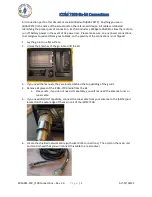
■
Connecting Receiver to Remote TV through VCR
This setup enables you to record transmitted audio and video on your remote
VCR and also enjoy the picture and sound on a remote TV at the same time.
1. Connect VCR and receiver using one of the provided A/V CABLE with RCA
plug, plug SCART to the SCART input of VCR, RCA to receiver. Then connect
TV and SCART output of VCR using a “SCART to SCART A/V CABLE”
(with must be purchased additionally). Please follow the instruction figure
below.
2. If your TV has A/V input jacks, connect another set of A/V cables to the
TV's A/V input jacks and to the A/V output jacks on your VCR.
3. If your TV does not have any A/V input jacks, please connect a 75ohm
coaxial cable from the TV's antenna in (or RF in) to VCR's modulator output.
This feature is optional
4.
Plug one end of the sender power adapter into the back of the receiver and the
other end into any 230-volt (or 120 volt) wall outlet, DC in jack 9V/300mA.
Use only the adapter provided.
5.
Locate and orient the receiver to best video and sound quality please
according to the section of this manual titled "Orienting Units for optimum
Performance".
30
E. Orienting Units for Optimum Performance
This sender system should be placed on a flat, stable surface to prevent
damage to it from falling.
For optimum performance, both the audio/video and remote control antennas
should be carefully oriented as described below. In addition, to use the remote
extension feature, the transmitter itself must be specially oriented so it can relay
the converted remote control signal back to the audio/video source (see
following section titled "Using The Remote Control extension Feature"). For
maximum operating range, try to minimize the number of obstacles (e.g. your
TV or other electronics, large furniture) where between the transmitter and
receiver units.
THE AUDIO/VIDEO QUALITY ADJUST
Sender broadcast their high-quality audio and video using hidden omni-
directional antennas, only need to put the transmitter and receiver vertically and
make some adjustments, until picture and sound quality became perfect.
F. Using the Remote Control Feature
This sender system not only allows you to send crisp audio/video from one area
to another, it also gives you the ability to control the source using your existing
remote control device. It converts the infrared (IR) signal emitted by your remote
control to a radio frequency (RF) signal in UHF band at the receiver and sends it
back to the transmitter where the RF signal is converted back to the original IR
signal and beamed to the audio/video source.
There is one way to get your source A/V equipment to be controlled by using
existing remote control through remote control feature:
There’s a IR output cable wiring of 2288T, put the IR end close to IR receiving
part of A/V source.
31
Summary of Contents for AVS5010 011
Page 17: ......




































